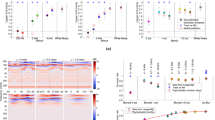No Heading
Summary:
To investigate the cerebral mechanisms of auditory detection of motion velocity in the human brain, neuromagnetic fields elicited by six moving sounds and one stationary sound were investigated with a whole-cortex magnetoencephalography (MEG) system. The stationary sound evoked only one clear response at a latency of 109±6 ms (first response, or M100), but the six moving sounds evoked two clear responses: an earlier response at a latency of 116±7 ms (M100) and a later response at a latency ranging from 180 to 760 ms (magnetic motion response, or MM). The latency and amplitude of the MM were inversely related to the velocity of the moving sounds (p<0.02). The magnetic source of MM was related to the velocity of the moving sounds (p<0.05). A dynamic neuromagnetic response, MM, was elicited by the moving sounds, which likely encoded the neural processing of auditory detection of motion velocity. A specific neural network that processes the motion velocity in the human brain probably includes the bilateral superior temporal cortices and the brainstem. The left posterior and lateral part of the auditory cortex may play a pivotal role in the auditory detection of motion velocity.
Similar content being viewed by others
References
Doan, D.E. and Sounders, J.C. Sensitivity to simulated directional sound motion in the rat primary auditory cortex. J. Neurophysiol., 1999, 81:2075–2087.
Griffiths, T.D., Bates, D., Rees, A., Witton, C., Gholkar, A. and Green, G.G. Sound movement detection deficit due to a brainstem lesion. J. Neurol. Neurosurg. Psychiatry, 1997, 62:522–526.
Griffiths, T.D. and Green, G.G. Cortical activation during perception of a rotating wide-field acoustic stimulus. Neuroimage, 1999, 10:84–90.
Griffiths, T.D., Green, G.G., Rees, A. and Rees, G. Human brain areas involved in the analysis of auditory movement. Hum. Brain Mapp., 2000, 9:72–80.
Griffiths, T.D., Rees, G., Rees, A., Green, G.G., Witton, C., Rowe, D., Buchel, C., Turner, R. and Frackowiak, R.S. Right parietal cortex is involved in the perception of sound movement in humans. Nat. Neurosci., 1998, 1:74–79.
Hari, R., Kaila, K., Katila, T., Tuomisto, T. and Varpula, T. lnterstimulus interval dependence of the auditory vertex response and its magnetic counterpart: implications for their neural generation. Electroencephatogr. Clin. Neurophysiol., 1982, 54:561–569.
Johnsrude, I.S., Penhune, V.B. and Zatorre, R.J. Functional specificity in the right human auditory cortex for perceiving pitch direction. Brain, 2000, 123 (Pt 1):155–163.
Kaiser, J., Lutzenberger, W., Preissl, H., Ackermarm, H. and Birbaumer, N. Right-hemisphere dominance for the processing of sound-source lateralization. J. Neurosci., 2000, 20:6631–6639.
Lutfi, R.A. and Wang, W. Correlational analysis of acoustic cues for the discrimination of auditory motion. J. Acoust. Soc. Am., 1999, 106:919–928.
Makela, J.P. and McEvoy, L. Auditory evoked fields to illusory sound source movements. Exp. Brain Res., 1996, 110:446–454.
Marshall, J.C. Auditory neglect and right parietal cortex. Brain, 2001, 124:645–646.
Oldfield, R.C. The assessment and analysis of handedness: The Edinburgh Inventory. Neuropsychologia, 1971, 9:157–200.
Perrott, D.R. and Marlborough, K. Minimum audible movement angle: marking the end points of the path traveled by a moving sound source. J. Acoust. Soc. Am., 1989, 85:1773–1775.
Perrott, D.R. and Musicant, A.D. Minimum auditory movement angle: binaural localization of moving sound sources. J. Acoust. Soc. Am., 1977, 62:1463–1466.
Perrott, D.R. and Tucker, J. Minimum audible movement angle as a function of signal frequency and the velocity of the source. J. Acoust. Soc. Am., 1988, 83:1522–1527.
Poirier, P., Jiang, H., Lepore, F. and Guillemot, J.P. Positional, directional and speed selectivities in the primary auditory cortex of the cat. Hear. Res., 1997, 113:1–13.
Pratt, H. and Polyakov, A. Electrophysiological evidence of a sound localizing binaural subsystem in the human auditory brainstem. J. Basic Clin. Physiol. Pharmacol., 1996, 7:235–244.
Pratt, H. and Polyakov, A. Evoked potentials in sound localization: timing of activity along the auditory pathway. Electroencephalogr. Clin. Neurophysiol. Suppl., 1999, 50:235–242.
Ungan, P., Erar, H., Ozturk, N. and Ozmen, B. Human long-latency potentials evoked by monaural interruptions of a binaural click train: connection to sound lateralization based on interaural intensity differences. Audiology, 1992, 31:318–333.
Ungan, P., Yagcioglu, S. and Goksoy, C. Differences between the N1 waves of the responses to interaural time and intensity disparities: scalp topography and dipole sources. Clin. Neurophysiol., 2001, 112:485–498.
Wallace, I.F., Rose, S.A., McCarton, C.M., Kurtzberg, D. and Vaughan, H.G., Jr. Relations between infant neurobehavioral performance and cognitive outcome in very low birth weight preterm infants. J. Dev. Behav. Pediatr., 1995, 16:309–317.
Warren, J.D., Zielinski, B.A., Green, G.G., Rauschecker, J.P. and Griffiths, T.D. Perception of sound-source motion by the human brain. Neuron, 2002, 34:139–148.
Xiang, J., Chuang, S., Wilson, D., Otsubo, H., Pang, E., Holowka, S., Sharma, R., Ochi, A. and Chitoku, S. Sound motion evoked magnetic fields. Clin. Neurophysiol., 2002, 113:1–9.
Xiang, J., Hoshiyama, M., Koyama, S., Kaneoke, Y., Suzuki, H., Watanabe, S., Naka, D. and Kakigi, R. Somatosensory evoked magnetic fields following passive finger movement. Brain Res. Cogn. Brain Res., 1997a, 6:73–82.
Xiang, J., Kakigi, R., Hoshiyama, M., Kaneoke, Y., Naka, D., Takeshima, Y. and Koyama, S. Somatosensory evoked magnetic fields and potentials following passive toe movement in humans. Electroencephalogr. Clin. Neurophysiol., 1997b, 104:393–401.
Author information
Authors and Affiliations
Corresponding author
Additional information
We thank Dr. Paul Babyn for his help and suggestions in these experiments. This paper was prepared with the assistance of Prof. Sharon Nancekivell, medical editor, Guelph, Ontario, Canada. This study was partially supported by the Savoy Foundation (Research Grant 77227).
Rights and permissions
About this article
Cite this article
Xiang, J., Daniel, S., Ishii, R. et al. Auditory Detection of Motion Velocity in Humans: a Magnetoencephalographic Study. Brain Topogr 17, 139–149 (2005). https://doi.org/10.1007/s10548-005-4447-4
Accepted:
Published:
Issue Date:
DOI: https://doi.org/10.1007/s10548-005-4447-4



